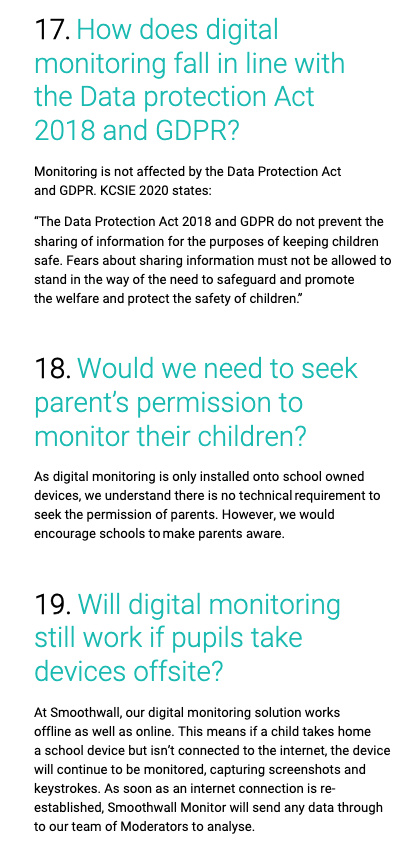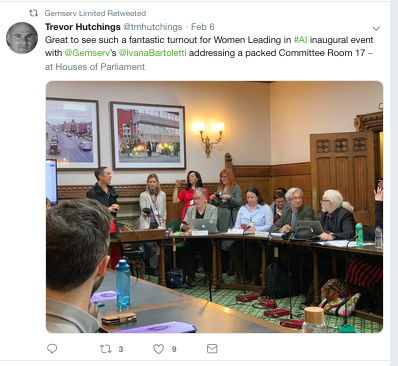Today Keir Starmer talked about us having more control in our lives. He said, “markets don’t give you control – that is almost literally their point.”
This week we’ve seen it embodied in a speech given by Oracle co-founder Larry Ellison, at their Financial Analyst Meeting 2024. He said that AI is on the verge of ushering in a new era of mass behavioural surveillance, of police and citizens. Oracle he suggested, would be the technological backbone for such applications, keeping everyone “on their best behaviour” through constant real-time machine-learning-powered monitoring.(LE FAQs 1:09:00).
Ellison’s sense of unquestionable entitlement to decide that *he* should be the company to control how all citizens (and police) behave-by-design, and his omission of any consideration of any democratic mandate for that, should shock us. Not least because he’s wrong in some of his claims. (There is no evidence that having a digital dystopia makes this difference in school safety, in particular given the numbers of people known to the school).
How does society trust in this direction of travel in how our behaviour is shaped and how corporations impose their choices? How can a government promise society more control in our lives and yet enable a digital environment, which plays a large part in our everyday life, of which we seem to have ever less control?
The new government sounds keen on public infrastructure investment as a route to structural transformation. But the risk is that the cost constraints mean they seek the results expected from the same plays in an industrial development strategy of old, but now using new technology and tools. It’s a big mistake, huge. And nothing less than national democracy is at stake because individuals cannot meaningfully hold corporations to account. The economic and political context in which an industrial strategy is defined is now behind paywalls and without parliamentary consensus, oversight or societal legitimacy in a formal democratic environment. The nature of the constraints on businesses’ power were once more tangible and localised and their effects easier to see in one place. Power has moved away from government to corporations considerably in the time Labour was out of it. We are now more dependent on being users of multiple private techno-solutions to everyday things often that we hate using, from paying for the car park, to laundry, to job hunting. All with indirect effects on national security, on service provsion at scale, as well as direct everyday effects for citizens and increasingly, our disempowerment and lack of agency in our own lives.
LinkedIn this week first chose not to ask users at all in what has become the OpenAI modus operandi of take first, and ask forgiveness later to grab our personal data from the platform to train “content creation AI models.” (And then it did a U-turn.)
Data Protection law is supposed to offer people protection from such misuse, but without enforcement, ever more companies are starting to copy each other on rinse and repeat.
The Convention 108 requires respect for rights and fundamental freedoms, and in particular the right to privacy, and special categories of data which may not be processed automatically unless domestic law provides appropriate safeguards. It must be obtained fairly. In the cases of many emerging [Generative] AI companies have disregarded fundamentals of European DP laws: Purpose limitation for incompatible uses, no relationship between the subject and company, lack of accuracy or even being actively offered a right to object when in fact it should be a consent basis, means there is unfair and unlawful processing. If we are to accept that anyone at all can take any personal data online and use it for an entirely different purpose to turn into commercial products ignoring all this, then frankly the Data Protection authorities may as well close. Are these commercial interests simply so large that they believe they can get away with steam-rollering over democratic voice and human rights, as well as the rule of (data protection) law? Unless there is consistent ‘cease and desist’ type enforcement, it seems to be rapidly becoming the new normal.
If instead regulators were to bring meaningful enforcement that is dissuasive as the law is supposed to be, what would change? What will shift practice on facial recognition in the world as foreseen by Larry Ellison, and shift public policy to sourcing responsibly? How is democracy to be saved from technocratic authoritarianism going global? If the majority of people in living in democracies are never asked for their views, and have changes imposed on their lives that they do not want how do we raise a right to object and take control?
While the influence in in our political systems of institutions, such as Oracle, and their financial interests are in growing ever more-, and ever larger -, AI models, the interests of our affected communities are not represented in state decisions at national or global levels.
While tools are being built to resist content scraping from artists, what is there for faces and facts, or even errors, about our lives?
Ted Chiang asked in the New Yorker in 2023, whether an alternative is possible to the current direction of travel. “Some might say that it’s not the job of A.I. to oppose capitalism. That may be true, but it’s not the job of A.I. to strengthen capitalism, either. Yet that is what it currently does.” The greatest current risk of AI is not what we imagine from I, Robot he suggested, but “A.I.-supercharged corporations destroying the environment and the working class in their pursuit of shareholder value.”
I remember giving a debate talk as a teen thirty years ago, about the risk of rising sea levels in Vanuatu. It is a reality that causes harm. Satellite data indicates the sea level has risen there by about 6 mm per year since 1993. Someone told me in an interesting recent Twitter exchange, when it comes to climate impacts and AI that they are, “not a proponent of ‘reducing consumption'”. The reality of climate change in the UK today, only hints at the long-term consequences for the world from the effects of migration and extreme weather events. Only by restraining consumption might we change those knock-on effects of climate change in anything like the necessary timeframe, or the next thirty years worsen more quickly.
But instead of hearing meaningful assessment of what we need in public policy, we hear politicians talk about growth as what they want and that bigger can only be better. More AI. More data centres. What about more humanity in this machine-led environment?
While some argue for an alternative, responsible, rights respecting path as the only sustainable path forwards, like Meeri Haataja, Chief Executive and Founder, Saidot, Helsinki, Finland in his August letter to the FT, some of the largest companies appear to be suggesting this week, publishing ads in various European press, that they seem to struggle to follow the law (like Meta), so Europe needs a new one. And to paraphrase, they suggest it’s for our own good.
And that’s whether we like it, or not. You might not choose to use any of their Meta products but might still be being used by them, using your activity online to to create advertising market data that can be sold. Researchers at the University of Oxford analysed a million smartphone apps and found that “the average one contains third‑party code from 10 different companies that facilitates this kind of tracking. Nine out of 10 of them sent data to Google. Four out of 10 of them sent data to Facebook. In the case of Facebook, many of them sent data automatically without the individual having the opportunity to say no to it.” Reuse for training AI is far more explicit and wrong and “it is for Meta [or any other company] to ensure and demonstrate ongoing compliance.” We have rights, and the rule of law, and at stake are our democratic processes.
“The balance of the interests of working people” must include respect for their fundamental rights and freedoms in the digital environment as well as supporting the interests of economic growth and they are mutually achievable not mutually exclusive.
But in the UK we put the regulator on a leash in 2015, constrained by a duty towards “economic growth”. It’s a constraint that should not apply to industry and market regulators, like the ICO.
While some companies plead to be let off with their bad behaviour, others expect to profit from encouraging the state to increase the monitoring of ours or asking that the law be written ever in their favour. Regulators need to stand tall, and stand up to it and the government needs to remove their leash.
Even in 1959, Labour MPs included housewives concerned with being misled by advertisers and manufacturers (06:40). Many of the electoral issues have stayed the same in over 65 years. But the power grab going on in this era of information age is unprecedented.
We need not accept this techno-authoritarianism as a “new normal” and inevitable. If indeed as Starmer concluded, “Britain belongs to you“, then it needs MPs to act like it and defend fundamental rights and freedoms to uphold values like the rule of law, even with companies who believe it does not apply to them. With a growing swell of nationalism and plenty who may not believe Britain belongs to all of us, but that, ‘Tomorrow belongs to Me‘, it is indeed a time when “great forces demand a decisive government prepared to face the future.”
See also Part 2: Farming out our Children. AI AI Oh.
The video referenced above is of Dr. Sasha Luccioni, the research scientist and climate lead at HuggingFace, an open-source community and machine-learning platform for AI developers, and is part 1 of the TED Radio Hour episode, Our tech has a climate problem.







